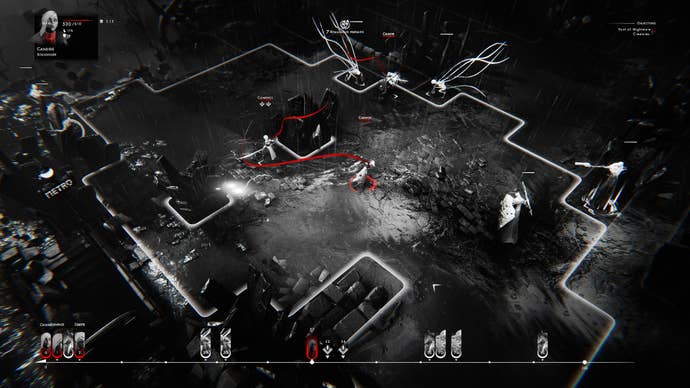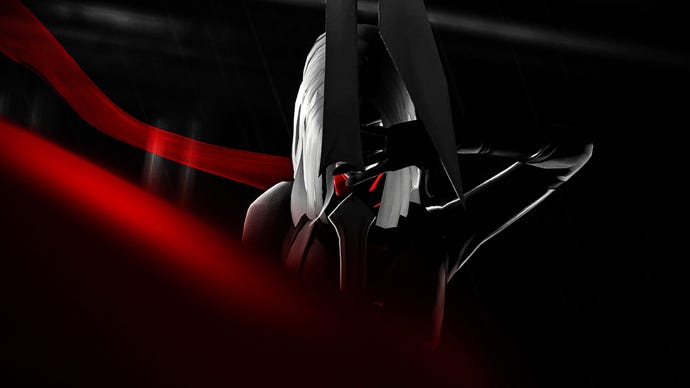Othercide Review: My Immortal
A tactics game that taps into our inner goth rock fan.
This article first appeared on USgamer, a partner publication of VG247. Some content, such as this article, has been migrated to VG247 for posterity after USgamer's closure - but it has not been edited or further vetted by the VG247 team.
I was an embarrassingly big fan of Evanescence when they made their debut back in 2003. Songs like "My Immortal" soundtracked a steamy summer spent working security and subsisting on ramen noodles, nodding along to lyrics like "These wounds won't seem to heal / this pain is just too real / there's just too much that time cannot erase."
Othercide, a new tactics game launching today on PS4, Steam, and Xbox One, captures that feeling well, and not just because of its goth-pop soundtrack, which is straight out of a mid-2000s Hot Topic. It's colored mainly in black and white, the only accents being the occasional flecks of red from blood. The villains bear a strong resemblance to the villains of The Dark Crystal, renowned for being perhaps the darkest story in the Jim Henson oeuvre. This is a tactics game that revels in wearing Corpse Bride T-shirts and writing very long LiveJournal posts.
In Othercide, you control an army of women who are created, fully-formed, from a birthing pool, assigned one of four classes, and marched out onto an isometric battlefield to battle an army of evil doctors. The story of a mysterious plague—conveyed mainly through ambient dialogue and moody narration—is sparse. The emphasis is much more on the tactics, which manage to rise above even the overwrought, but still charming, art.
In a year rich with excellent strategy games like Gear Tactics, Othercide stands out thanks to its wide array of clever systems, smartly-considered roguelite format, and general atmosphere. It's tightly-designed, with layers of mechanics that tie in nicely to its mixture of genres. Maybe my only criticism—and it's not a small one—is that it's almost too tight, making it feel more like a proof-of-concept than a full-blooded game in some ways.
That last point is exemplified by the first real "level," which is divided into a handful of days ending with a boss. Each day offers a handful of randomized missions that fall into a series of buckets—Rescue, Hunt, and so forth—in which you can build up your "Daughters." When you complete a mission, the day is finished and your team rests. Your ultimate goal is to get three characters to the confrontation with the boss relatively unscathed—no easy feat given that the only way to heal is to sacrifice a character of equal level.
By the nature of Othercide's format, you're pretty much guaranteed to fail in your first few attempts to take down the first boss. Even if you make it to the end of the week, your team will be cut down with ease. I wasn't able to beat the Surgeon, a nasty character wielding giant blades who has a penchant for area attacks, until I had spent a good deal of time leveling up a powerful party. Even with that team, it still came down to the very last shot.

In the end, it was a thrilling battle, demanding that I use every trick at my disposal to survive the Surgeon's crushing attacks. It was also pretty much where I wanted to stop. Having finished the first "Era," I was left with the distinct sense that I had seen everything there was to see in Othercide, and to a great extent I had. Oh sure, there were more abilities to unlock, more bosses to fight, and even a whole new class to discover, but the mission archetypes remained much the same, and so did the overall flow. With a couple exceptions, Othercide pretty much shows you all of its tricks right from the start, leaving little room to further develop its concept.
Still, what's there is pretty neat. Othercide only lets you bring three characters to the battlefield at any given time, but that's fine because at higher levels it's a little like having three different John Wicks under your command. The three initial classes—which broadly fall under the attack, defense, and support archetypes—all bring something unique to the battlefield, whether it's the raw speed and power of the Blademaster class, or the ability to shut down enemies at range with a Soulslinger. In the right circumstances you can wreak absolute havoc on your enemies, abusing interrupt abilities and counters to great effect. In a clever touch, Othercide implements a turn-based timeline similar to what you might find in Grandia, and a huge part of the strategy is bound up in manipulating that timeline to your advantage. It worked in Grandia and it works here, ratcheting up the tension as you sweat out interrupts while trying to gain the initiative.

Othercide is likewise interesting in the way that it allows you to manipulate death and resurrection, lending it a sense of continuity absent in other roguelites. As the game goes on, you unlock more and more perks that give you a leg up when the timeline resets—a total party wipe will set you back to the very beginning—allowing you to resurrect valued party members or activate stat boosts. Resurrection tokens can also be earned by completing Rescue missions, probably the most annoying mission type in the game, but also the most valuable. Escorting that little kid through hordes of enemies isn't easy, but it's worth it if you can pull back a high-level character from the other side.
It all adds up to a very smart, sometimes ambitious, tactics game—one with a standout art style that looked great without overtaxing my PC. It brings to the table a lot of interesting ideas, particularly the timeline, that I hope are picked up by other games in the future. Nevertheless, it's a little hard to unreservedly recommend Othercide, as it became a grind after the first few hours. I love the systems and its exaggerated atmosphere; playing the same three mission types over and over again, not so much.
The kindest thing I can say for Othercide is that it serves to further illuminate what the tactics genre is capable of, and that it brought back weirdly fond memories of all those long nights spent at the security desk with Fallen playing on loop. It's yet more proof of the ongoing tactics renaissance, and that maybe, just maybe, we can all be nostalgic for early-2000s goth rock, if only for a moment.
ConclusionOthercide mixes a mid-2000s Hot Topic aesthetic with tightly-designed tactics that work very well, even if it largely runs out of new ideas after the first few hours. It's more a proof-of-concept than anything, but it's smart and entertaining while it lasts.


